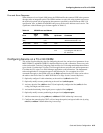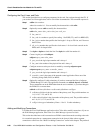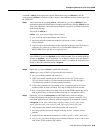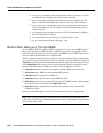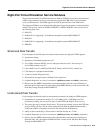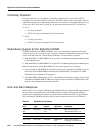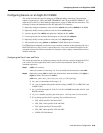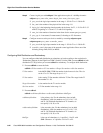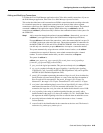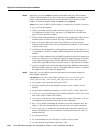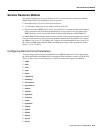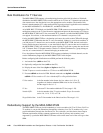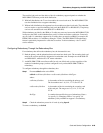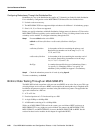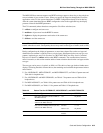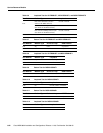
Card and Service Configuration 6-45
Configuring Service on an Eight-Port CESM
Adding and Modifying Connections
Use either the Cisco WAN Manager application or the CLI to add or modify connections. If you use
the WAN Manager application, refer to the Cisco WAN Manager Operations Guide.
This section describes how to add a connection to a PXM in a stand-alone node according to the rules
for a standard connection or a management connection in the form of either a three-segment
connection or a DAX con. See “Rules for Adding Connections” earlier in this chapter. The preferred
command is addcon. If the application requires NSAP addressing, use addchan to add the
connection and cnfchan if you need to modify it. Refer to the command reference for the syntax. On
the CESM CLI:
Step 1 Add a connection through the preferred command addcon. (Alternatively, you can use
addchan if your application requires the NSAP format of endpoint specification.)
Execute addcon at both ends of the connection—unless the remote endpoint is on port 34
of a PXM (see the note at the end of this step). The maximum number of connections for
the MGX-CESM-8T1 is 248 and 192 for the MGX-CESM-8E1. Note that, because you
can add only one connection per port, addcon does not request a connection number.
The system automatically assigns the next available channel number, so the addcon
command does not require it. However, some related commands require a channel
number. To see the channel number after you add a connection, use dspcons.
The syntax for addcon is:
addcon <port_num> <sig_type> <partial_fill> <cond_data> <cond_signalling>
[controller_type] [mastership] [remoteConnId]
• port_num is the logical port number. This port must already exist (see addport).
• sig_type is a number indicating the type of signaling: 1 specifies basic signaling,
2 specifies E1 CAS, 3 specifies ds1SFCAS (DS1 Superframe CAS), and 4 specifies
ds1ESFCAS (DS1 Extended Superframe CAS).
• partial_fill is a number representing the number of bytes in a cell. It can be either 0 to
specify that the cell must contain 48 bytes or a non-0 value that fixes the number of
bytes in each cell. For structured E1, the partial_fill range is 20–47 bytes. For
structured T1, the range is 25–47 bytes. Unstructured T1 or E1 can be 33–47 bytes.
• cond_data is the conditioning data in case of loss of signal (LOS). It is always 255 for
unstructured data transfer or 0–255 for structured data transfer. For a voice
connection, the larger the cond_data value, the louder the hiss heard in case of LOS.
• cond_signalling is the string of condition signaling bits that you specify with a
decimal number in the range 0–15, where, for example, 15=1111, and 0=0000. These
bits represent the ABCD signaling to the line or network when an underflow occurs.
• mastership indicates whether this endpoint is the master or slave. 1=master.
2=slave (default).
• remoteConnId is the identification for the connection at the slave end. The format is
nodename.slot_number.port_number.vpi.vci.



